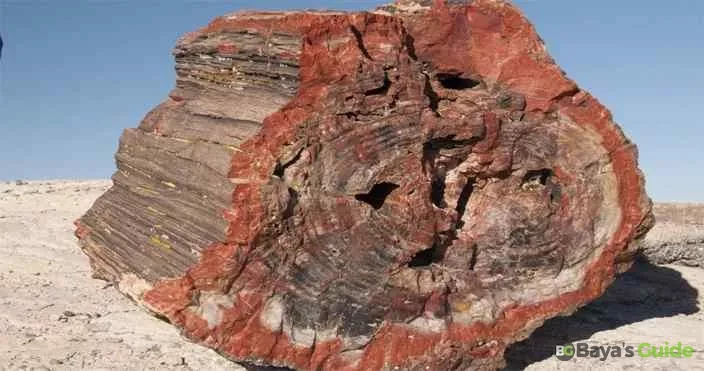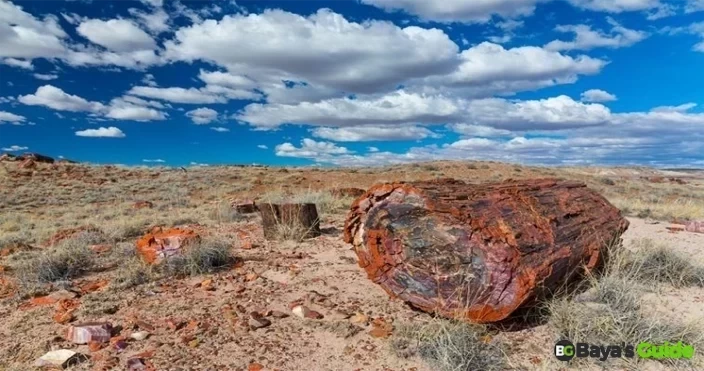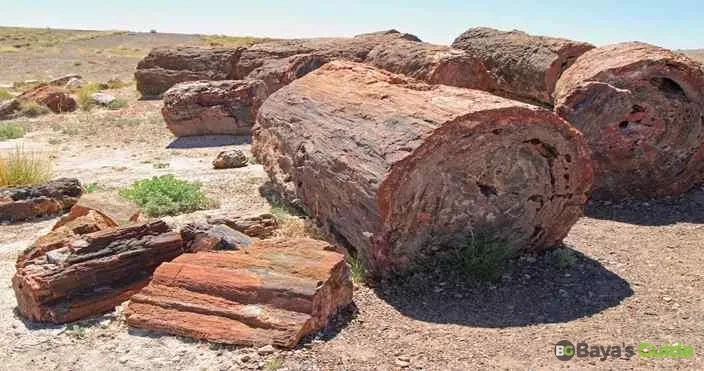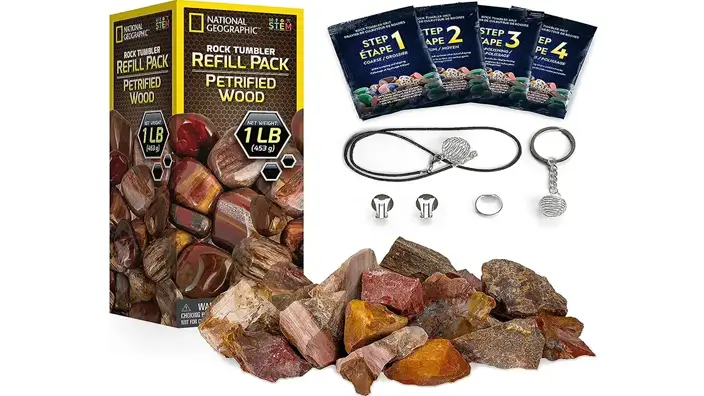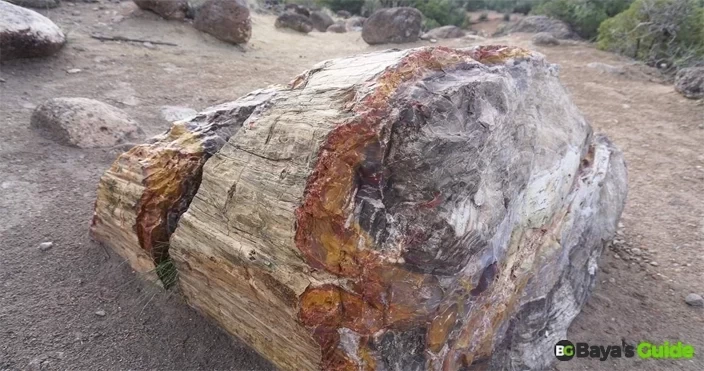Have you ever walked in nature to discover a weird-looking rock that got you thinking if it were a mere stone? Step into the wonderful realm of petrified wood – the naturally saved memory. Fossilized wood is not just another rock; it's rather a stunning snapshot of the past. It is an aged piece of ancient forest turned into stone by a beautiful process of molding it into minerals.
Petrified wood is like Mother Nature's crystal ball, freezing in time the images of long-gone places in rock form. However, the question is, how do you recognize this geological rarity? Fear not! We are here to help you get through this with basic steps and instructions. Hence, irrespective of whether you are a sighted nature lover or an uncultured fossil hunter, get involved in this tour as we divulge the wonders of this wood and explore the geological stories that are inscribed on the stones.
Table of Contents
- What Is Petrified Wood?
- Ways To Identify Petrified Wood
- Rock Tumbler Refill Kit – 1 Lb. Mix of Genuine Petrified Wood Fossils for Rock Polishers
- Types Of Petrified Wood
- Petrified Wood Identification Book
- Is Petrified Wood Rare?
- Determining The Age Of Petrified Wood
- Fake Petrified Wood
- Frequently Asked Questions
- Conclusion
What Is Petrified Wood?
Petrified wood is an exciting relic because it may shed light on the environment in which the tree once flourished. In ancient times, people found petrified wood a useful one. The wood originated from deciduous tree species.
When a tree dies and is buried in sediment, groundwater rich in dissolved solids can dissolve the organic matter and leave behind inorganic minerals such as silica, calcite, pyrite, and opal. The rock that emerges from this lengthy process is sometimes called "petrified wood" due to its resemblance to wood.
You can get petrified wood specimens from parks, but it may be illegal, especially if you are in the United States. In these parks, getting petrified wood samples is no longer an issue for you. You can analyze a wood sample at different magnifications. You can do it to study the tracheid patterns (wood cell structure).
Ways To Identify Petrified Wood
Identifying petrified wood might be difficult to recognize at first, but with experience comes expertise. There are a few significant signs that may be used to spot petrified wood:
1- Appearance & Texture That Resemble Wood
Petrified wood is a fascinating study subject since it often preserves the look and feel of the wood it once was while being turned into stone. Carefully examining the wood's grain may reveal the tree's age and growth history.
- Some branches will become solid spheres known as knots at their nodes. The natural bark texture is typically preserved in petrified wood.
- However, the familiarity with regular wood that one would anticipate is missing in petrified wood.
- Instead, it's cold and solid like a rock, inflexible and unyielding.
- The original tree has been transformed into stone by replacing its organic components with mineral components.
2- Extensive Range Of Colors
A wide range of hues may be seen in most petrified wood because of the many minerals that have replaced the original wood components during the process.
- Petrified wood with crystals, for instance, will become vibrant autumnal red, orange, and yellow hues when exposed to iron.
- However, another side to the coin is that copper can sometimes reflect gorgeous blue and green hues.
- Petrified wood with crystals appears as black or gray petrified wood when carbon is present and pink or even black when manganese is present.
The minerals in the groundwater react chemically with the organic components in the wood to produce these stunning color changes. Petrified wood with crystals preserves the geological conditions of the Earth as they were millions of years ago, making it a true time capsule.
3- Weight Of Petrified Wood
- One of the first things you would notice about petrified wood with crystals is how hefty it is. In contrast to absorbent and lightweight ordinary wood, petrified wood is solid and heavy. The transformation of the wood into stone is to blame for this.
- Minerals from the soil and adjacent water eventually replaced the original wood over millions of years. Petrified wood is significantly heavier than it appears because its minerals are denser than the wood it ever was.
- Anything that looks like wood but is much heavier than usual is most likely petrified wood. The unusual characteristic of petrified wood that may be utilized to spot forgeries makes it all the more interesting.
4- Tree Ring Pattern
Carefully examining black petrified wood may reveal the original tree's growth rings. These ringlike structures are not limited to just one area of the tree or piece of wood; they can show up anywhere.
- The breadth of a tree's yearly growth rings is directly proportional to the rate of growth experienced by the tree during that particular year.
- These designs might be preserved in petrified wood with crystals for millions of years. The mineral replenishment process keeps the black petrified wood's annual growth rings and other structural components.
5- Wooden-Like Shape
Although petrified wood is beautiful, it is essential to remember that it was once a living tree. Trees that have fallen often lose branches, trunk sections, or sometimes the entire tree. Petrified wood may seem quite similar to the tree it originally was since its natural form is preserved during the process.
- However, erosion can further reduce the size of the petrified wood to tiny fragments after millions of years have passed. Thus, it is possible to come across petrified wood that seems like a round or oval rock but has a smooth, colorful inside.
- Petrified wood can have various appearances, but characteristics like tree rings and bark patterns can help determine its origin.
| Ways | Descriptions |
| Appearance & Texture That Resemble Wood | Petrified wood mirrors wood's appearance and texture, featuring grain, knots, and bark, but it lacks warmth, transforming into a cold stone. |
| Extensive Range Of Colors | Petrified wood displays diverse colors due to mineral replacement—crystals create autumnal tones, while copper introduces vivid blues and greens, preserving geological history. |
| Weight Of Petrified Wood | Heavier than natural wood, petrified wood gains density through mineral replacement over time, serving as a distinctive characteristic for identification. |
| Tree Ring Pattern | Black petrified wood reveals preserved growth rings, aiding in dating and uncovering the tree's growth history spanning millions of years through the mineral replacement process. |
| Wooden-Like Shape | Despite erosion, petrified wood retains the original tree's shape, resembling rocks or fragments; identifying features like tree rings persist even in smaller, colorful fragments. |
You Might Also Like:How To Make Black Salt
Rock Tumbler Refill Kit – 1 Lb. Mix of Genuine Petrified Wood Fossils for Rock Polishers
About This Item
- Discover Petrified Wood From Around The World - Explore 1 lb. of rough petrified wood fossils sourced globally, offering varying colors and sizes in refill kits.
- Four Grit Grades Included - Coarse, Medium, Fine, Polish: Transform your raw stones into stunning gemstones with this versatile refill kit, suitable for all rock tumblers.
- Craft Custom Jewelry - Enhance your creations with included accessories: 1 Necklace, 1 set of Earrings, 1 Keychain, and 1 Ring. Turn your polished gemstones into unique jewelry pieces.
- Educational Learning Guide - Dive into the fascinating world of petrified wood with our comprehensive Learning Guide, packed with amazing facts and insights.
- High-Quality Educational Toys - Count on top-tier educational products, backed by exceptional service. If your experience isn't exceptional, reach out, and we'll make it right.
Types Of Petrified Wood
Here are some of the types of petrified wood that you will find:
1- Araucarioxylon
Several live Araucaria species, including the Monkey Puzzle tree, have a common progenitor with the ancient conifer fossil Araucarioxylon. This type of petrified wood is precious due to the breathtaking beauty of its patterns and hues.
2- Palm Petrified Wood
- Petrified palm wood, obtained from palm trees that have since gone extinct, is an unusual and fascinating fossilized wood.
- This petrified wood has a distinctive speckled look due to rod-like structures inside the grain.
3- Petrified Oak Wood
- Ancient oak trees, which petrified wood originates from, are revered for their durability and resilience.
- Long-term burial often resulted in preserving oaks' distinctive growth rings and grain patterns in stone.
4- Petrified Cypress Wood
- Prehistoric cypress trees that thrive in moist, marshy environments are the source of petrified cypress wood.
- A fallen tree in one of these sites can be swiftly hidden by water and silt.
Petrified Wood Identification Book
Here, you will find answers to unlock the mysteries of the past that are revealed in the Petrified Wood identification books. With the help of these books, you will be able to learn the tongue of the native people who had seen this precious petrified wood with crystal or black petrified wood. Here are some books that can take you to dive deeper into the history of petrified wood.
- Ancient Forest by Frank J. Daniels and Richard Dayvault.
- Petrified wood by Frank J. Daniels.
Is Petrified Wood Rare?
Is it unusual to come upon petrified wood? Since only a tiny fraction of petrified wood can be appropriately carved and polished into gems, it is infrequent and valuable. Petrified does not always indicate poor durability or quality. The only rare kind of petrified wood is the green petrified wood.
Determining The Age Of Petrified Wood
Petrified wood's estimated age is heavily influenced by the circumstances under which it was formed. However, the age of petrified wood might be in the millions of years. The fossils in Arizona's Petrified Forest National Park are petrified and date back about 218 million years. Petrified wood like this was first formed in the Late Triassic, long before the emergence of dinosaurs. Perhaps even earlier samples have been stored away somewhere. Recent excavations in India's Dholavira area uncovered petrified wood with an estimated age of 247 to 66 million years.
Fake Petrified Wood
Even the most observant people can be tricked into believing that a fake petrified wood is natural. Petrified wood can be considered authentic if there is a solidified plant. There has been a fashion to make the unnatural petrified look accurate with modern materials. These types of duplicates are made with:
- Porcelain
- Resins
- Simple painted stones.
Perhaps the creator's only purpose in creating such a piece is for aesthetics or trends. Petrified wood crystals can be identified by their heft, vigilant examination, testing of the wood, and even when you trace them.
Frequently Asked Questions
Can You Test Petrified Wood?
Translucent pieces of petrified wood are the standard. Petrified wood may be identified by holding it up to the light; if it is fine, it is not petrified. If not, then it is the authentic petrified wood.
What Is The Difference Between Petrified Wood & Fossilized Wood?
Although all fossilized wood is technically petrified, not all fossilized wood is petrified. For an organism to be considered "petrified," permineralization in which minerals replace the original cells must have occurred. In this way, the building's interior layout may be known for posterity.
Does Petrified Wood Look Like Rock?
Petrified wood looks like any other kind of rock from the outside. Closer inspection, however, can expose the authentic wood grain and tree ring patterns.
Is Petrified Wood Hard Or Soft?
Petrified wood with crystals is as hard as a stone. Because it is no longer wood but rock, petrified wood is often more durable than regular wood. Petrification of wood usually involves the substitution of silica, a material with a hardness of 7. Opaline silica, which is softer, is occasionally used as a substitute.
Does Petrified Wood Sink Or Float?
Petrified wood is so dense that it sinks in water rather than floating on the surface. Denser objects, including those that aren't able to float on water, will decline.
Is Petrified Wood Heavy?
The theorized outcome is that petrified wood will be more hefty than untreated wood. In comparison, one cubic foot of black petrified wood weighs 97 pounds, but one cubic foot of water only weighs 62 pounds.
Conclusion
Acquiring a meek familiarity with how you can identify the petrified wood is essential to enjoying its actual aesthetic. It is one of the most arresting stones that can enthrall anyone’s sentiment, so this guide has elucidated in aspect about how one can categorize it from a counterfeit one and also conferences how many natures of petrified wood with crystals are there. Each has its own exquisiteness.

